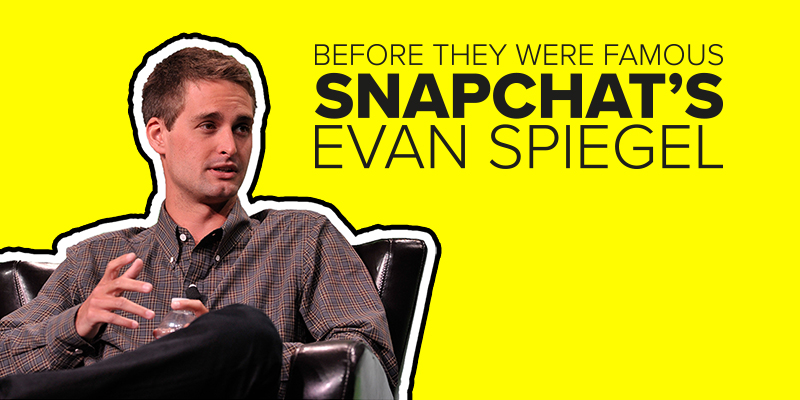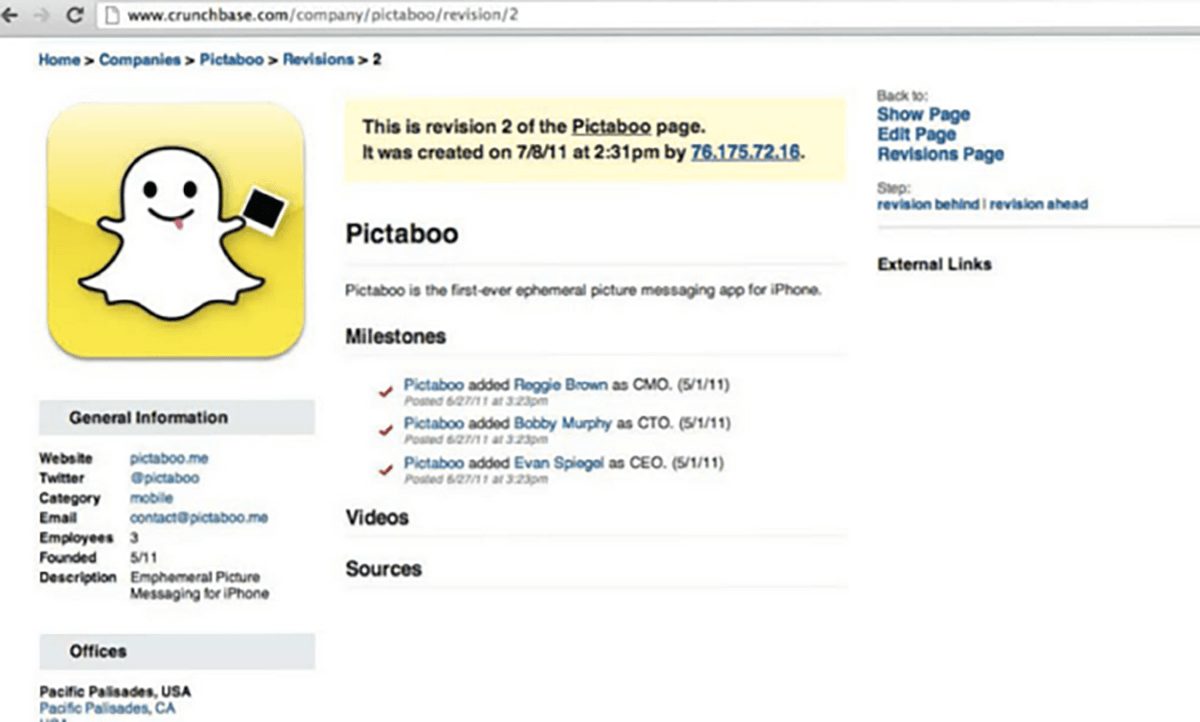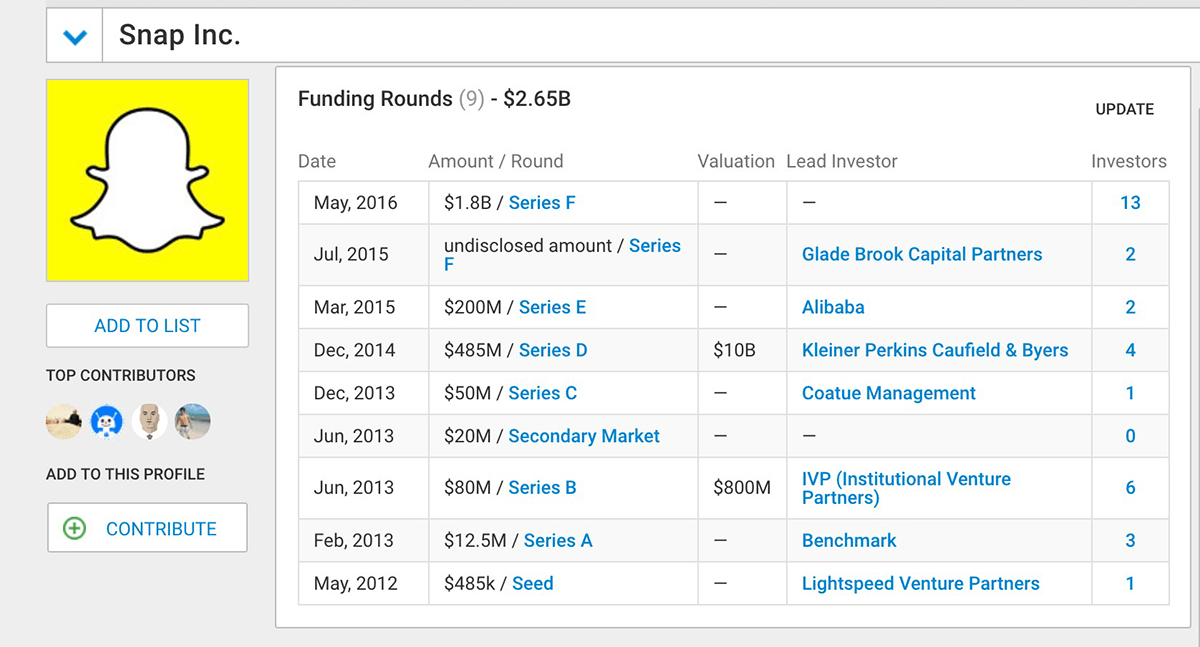 This story will only be available for 24-hours.
This story will only be available for 24-hours.
Or it would be if it appeared as a Story on Snap Inc.’s iconic Snapchat app. Unless deleted by you, other social networks keep everything you post, but with Snapchat, there is no history. Everything is temporary: opened Snaps disappear within seconds, Stories are only available for 24-hours, and even unopened Snaps disappear after 30-days.
Although Snapchat was an almost immediate success with 18-24 year olds, attracting seed funding in early 2012 couldn’t have been an easy task for a then 21-year old Evan Spiegel, and 23-year old Bobby Murphy.
Since then, Snapchat has continued to confound some, and delight others, all leading to an impressive IPO in early 2017, with the company valued in the $20bn-$30bn range.
Most companies with multiple founders inevitably end up with one founder receiving the lion’s share of attention, becoming the unofficial face. And with Snapchat, that face belongs to Evan Spiegel.
The Early Years
Evan Spiegel was born into a life of privilege, a fact he himself acknowledged during a Stanford business conference in April 2013:
“I am a young, white, educated male. I got really, really lucky. And life isn’t fair. So if life isn’t fair — it’s not about working harder, it’s about working the system.”
His parents were both successful lawyers, and Evan grew up in the Pacific Palisades, attending the exclusive Crossroads School for Arts & Sciences. Part of his privileged upbringing included spring breaks in Maui, summers at La Jolla’s Beach and Tennis Club, vacations to Europe, frequent shopping sprees, a personal chef, and even snowboarding by helicopter in Canada. But this unfairly suggests an early life of fun, with no ambition.
A journalism class he took at Crossroads involved not only writing for the school newspaper, but also selling a certain amount of advertising. Evan’s 10th Grade English teacher, Mitch Kohn, remembers him as a student who exceeded his sales goals, and helped coach the other children. It was also around this time that Evan enrolled for two continuing-education courses at the Otis College of Art and Design in Los Angeles. This after he became fascinated with design.
During his senior year at Crossroads, Evan managed to spend time as an unpaid intern at Red Bull, exposing him to various marketing and design projects. This might have inspired him to take a class at the Arts Center College of Design shortly before he started studying at Stanford, even though once he started at Stanford he appeared to be unsure of what he wanted to do.
Early Influences on Spiegel’s Career
Evan Spiegel’s path to tech innovation was significantly influenced by his educational experiences. At Crossroads School for Arts & Sciences, he was encouraged to think creatively and explore his interests in design. Courses at Otis College of Art and Design further developed his passion for creating user-centered designs. This nurturing environment exposed him to the principles of design thinking, which later became a key factor in his approach to app development at Snapchat.
The App Maker Emerges
Evan’s initial uncertainty over what he wanted to do after college saw him work as a paid intern for a biomedical company, and later as a careers instructor in South Africa. A family friend allowed Evan to sit in on an entrepreneurship and venture capital graduate-level class, which included talks by Google’s Eric Schmidt, YouTube’s Chad Hurley, and Intuit’s Scott Cook. These talks inspired Evan, who befriended Scott Cook, and landed a gig working with Scott and another engineer on txtWeb.
FutureFreshman
After the Intuit project, Evan launched futurefreshman.com with fellow fraternity brother, Bobby Murphy. The short-lived site was meant to guide users on how to manage college applications, but work on Pictaboo soon replaced work on futurefreshman.com.

The original idea for Pictaboo came from Reggie Brown, another fraternity brother who wished the photos he was sending to a girl could disappear. The idea interested Evan, and during the summer of 2011, Evan, Reggie and Bobby worked on Pictaboo. Bobby coded the app, which launched in July 2011, and the original company structure had Evan as CEO, Bobby as CTO, and Reggie as CMO.

A less than spectacular launch, and disagreements between Evan, Bobby, and Reggie led to the latter being ousted from the company a few weeks later. During the autumn of 2011, Evan and Bobby made changes to the app, relaunched as Snapchat, and began marketing to high school students. Things were much more successful this time around, and by the end of 2011 they had more than 1,000 daily users. By the time they landed their seed round of funding in April 2012, they had 100,000 users. And the rest – as they say – is history. Or myth.
The Pictaboo Transition to Snapchat
The shift from Pictaboo to Snapchat was not merely a rebranding effort. It involved refining the app’s core features to improve user experience. The team focused on enhancing the app’s speed and adding new features like the ability to draw on images, which contributed to its appeal among younger audiences. This strategic pivot helped Snapchat gain traction and increase daily active users.
Snapchat
Speaking at the Stanford Women in Business “Design Yourself” Conference in April 2013, Evan noted that:
“The rhetoric of the entrepreneur is deeply embedded in Stanford’s history. We’ve all heard the story — young, white male drops out of college to follow a dream. His commitment to this dream helps him through highs and lows. He refuses to be another cog in the ‘machine.’ This romantic business fairytale pervades Stanford culture — it is uniquely Silicon Valley.”
Of course, Evan Spiegel is now part of that fairytale. Soon after receiving $485,000 in seed funding, Evan dropped out of Stanford to focus on Snapchat full-time. It is a fairytale that doesn’t always have a happy ending but does always have highs and lows. Although Evan’s fairytale does have a happy ending – for him, anyway – it has also had some spectacular highs and lows.
In February 2013, soon after landing a round of Series A funding, Evan and Bobby were confronted with their first lawsuit – filed by Reggie Brown. The lawsuit would drag on well into 2014, before finally being settled with a $157.5m payout for Reggie Brown to disappear like a Snap.

Despite the lawsuit, the founders were still able to attract funding, with Series B and C concluded before the lawsuit was settled, and Series D soon after. And this also in spite of Evan rejecting a $3bn offer from Facebook in December 2013. Many wondered at the time if Evan would come to regret this, but with a personal net worth that currently exceeds what Facebook originally offered, it’s doubtful Evan has any regrets.
Snap IPO and Financial Growth
Snap Inc.’s path to their initial public offering in 2017 marked a significant milestone. The IPO valued the company at approximately $24 billion, reflecting investor confidence in its growth potential. Since the IPO, Snap has focused on expanding its offerings, which include advancements in augmented reality and new advertising opportunities. These efforts aim to strengthen revenue streams and provide shareholders with sustainable returns over the long term.
Snap Inc.
While still dealing with Reggie’s lawsuit, and after rejecting Facebook and surviving a malicious attack that exposed the personal information of millions of users, Evan was faced with a more personal controversy in May 2014. A few dozen email messages written by an 18-year old Evan – when he was still in Stanford – are released. And they show Evan as anything but wholesome. Evan immediately issues an apology:
“I’m obviously mortified and embarrassed that my idiotic emails during my fraternity days were made public. I have no excuse. I’m sorry I wrote them at the time and I was a jerk to have written them. They in no way reflect who I am today or my views towards women.”
and he has since managed to avoid any further personal controversies.
In September 2016, Snapchat Inc. – the parent company to the Snapchat app – rebranded as Snap Inc., and began referring to itself as a camera company:
Snap Inc. is a camera company. Our products empower people to express themselves, live in the moment, learn about the world, and have fun together.

At the same time, the company announced a new product: Spectacles, sunglasses with embedded cameras. So it isn’t too much of a stretch to accept that Snap Inc. is indeed a camera company; they just happen to be more well known for their social app.
Snap’s Company Culture and Values
Snap Inc. emphasizes a culture of creativity and inclusion, aiming to foster innovation among its workforce. The company implements policies that support diversity and offers training programs to develop leadership skills among employees. By creating an open and collaborative environment, Snap encourages its teams to push the boundaries of technology and redefine what is possible in the digital space.
Recent Organizational Changes and Challenges
In February 2024, Snap Inc. faced challenging times, announcing a layoff of 10% of its workforce to encourage more in-person collaboration. This adjustment followed a larger reduction in 2022. The company’s financial performance reflected these struggles, with stock prices dropping 30% by February, resulting in a market capitalization of $18 billion, which is below the level at the time of its 2017 IPO.
Despite these setbacks, Snap aimed to strengthen its leadership. On September 12, 2024, Snap appointed Jim Lanzone, CEO of Yahoo, to its board of directors, bringing new expertise to the company.
In addition to financial and structural changes, Snap addressed legal challenges. In June 2024, the company settled a lawsuit for $15 million related to allegations from the California Civil Rights Department. The suit charged that Snap practiced gender discrimination in pay and promotions and did not adequately prevent workplace sexual harassment. This settlement highlights Snap’s ongoing need to address and improve its workplace culture.
Snap’s Product Evolution
Beyond Snapchat, Snap Inc. has introduced products like Lens Studio, a platform allowing users to create AR experiences. Partnerships with other tech firms expand Snap’s reach into new markets, aligning with their vision of being more than a social app. These products demonstrate Snap’s commitment to innovation and open new avenues for user engagement and monetization strategies.
Conclusion
There is no denying that Evan Spiegel had a privileged childhood, and that he got lucky. But as you explore the brief history of Snapchat, you also discover that Evan didn’t become one of the world’s youngest billionaires without any effort. As suggested by his talk at the Stanford Women in Business “Design Yourself” Conference, he “[refused] to be another cog in the ‘machine.’”

2 thoughts on “App Builders Before They Were Famous: Snap Inc.’s Evan Spiegel”